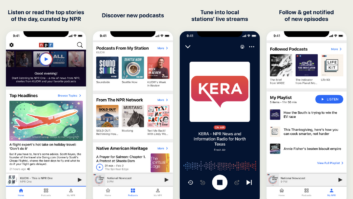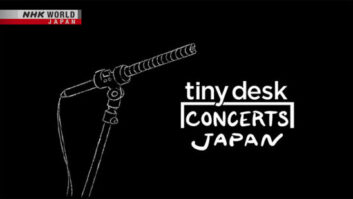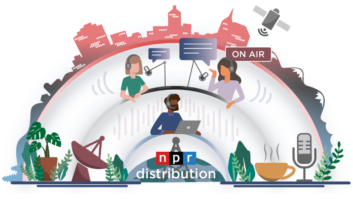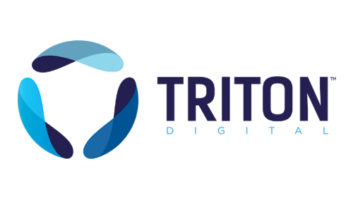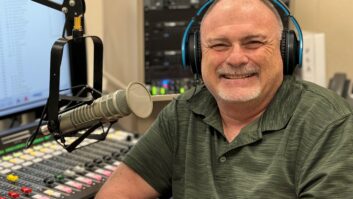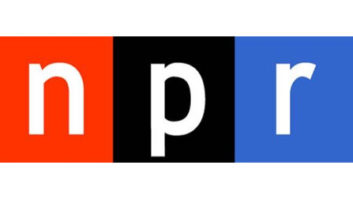While others Consolidate, NPR expands
Jul 1, 2003 12:00 PM, By Kent Kramer, CBRE
Key playersEquipment list
On arrival at National Public Radio West in Culver City, CA, the building is reminiscent of an old manufacturing facility, but once inside the building is open and inviting. The roof of the building is constructed with wood trusses that span almost the entire building. This provides an interior that is open and spacious. Skylights in the roof provide lots of natural light during the day. Though the building maintains its factory feel throughout, its design provides a nice contrast to the high-tech surroundings of the studios.
The control room has three positions behind the board operator for a show’s producer, director and other personnel. Photo by Edward Colver, courtesy of Studio Bau:ton.

Studio B is used for The Tavis Smiley Show. Four independent tables on wheels and umbilical cords allow for the room to be reconfigured. Photo by Edward Colver, courtesy of Studio Bau:ton.

Studio B. Photo by Kent Kramer.

Studio C has positions for two hosts and two guests. The Control Room is visible from all positions. Photo by Edward Colver, courtesy of Studio Bau:ton.

The main audio switching station provides direct access to all the audio sources and destinations. Photo by Kent Kramer.

The technical operations console routes programming between the studios, the Dalet system and the Washington studios. This room is also used for scheduled program feed recording and technical-support calls. Photo by Kent Kramer.

The past tenant, an Internet video production firm, left the building with a technical infrastructure that most engineers can only dream about: a high-capacity electrical service with a matching generator transfer switch, a large UPS and a large number of items that could be modified for NPR’s use with little effort.
Offices flank the outside wall on one side of the building and a large, open area outside the offices, filled with cubicles for programming and production staffs, allow for comfortable working spaces for everyone. Centered in the building and directly inside the lobby is a kitchen and lounge that provide a comfortable place for everyone to take a break from their desks while remaining close to their offices. The common areas also benefit from skylights that provide natural light to the office spaces.
The studio area occupies the other side of the building. When planning began on the facility, NPR was determined that the building should provide redundant facilities, similar to the Washington, D.C., operation. This was also NPR’s chance to enhance its West Coast presence. The overall plans also included room for additional growth. Studio A was left open and undeveloped with tentative plans to build a studio capable of being used as a large performance and recording facility. Plans also included an associated control room.
Both main and backup
Because this is NPR’s second-largest facility, it has the duty of providing backup to the network operations. After the events of the past few years, plans were included that would keep the network active and on schedule should the Washington facility become unavailable. Nearly 5 terabytes (TB) of RAID-5 storage provide plenty of linear audio storage. The Los Angeles facility was built from the ground up with the plan to operate with linear audio. Plans to convert the Washington facility to linear audio are in place now as well.
A technical operations center (TOC) provides the central control point for the facility. From this point, technicians are able to control the Dalet audio system and the Klotz Vadis control surfaces in each room. All of the computers in the facility are on Raritan Computer KVM switches. With the KVM switches, the person manning the TOC can bring up any terminal in the facility to aid in troubleshooting or to answer operational questions by users without the need to make a trip outside the TOC. The TOC also acts as a central recording facility for incoming feeds.
Situated around the TOC are five edit suites. The edit suites are housed in prefabricated sound booths built by Wenger. Each suite is centered around a four-fader Vadis console and a Dalet 5.1 workstation. Sony DAT machines and Neumann U-87 microphones complement the rooms. Edit 4 and 5 are also outfitted with Telos Zephyr Xstream ISDN codecs to enable a direct connection to Washington should the need arise. Denon CD and minidisc players are also available in each room. As in all the studios, all analog-to-digital and digital-to-analog conversion is done by the Klotz system.
Remote control
Control Room B with its associated Studio B plays host to The Tavis Smiley Show, which provided many challenges during the construction. Because of the host’s considerable commitments to his charitable foundation, Smiley originates his show from his offices in the Crenshaw District of Los Angeles. A T1 circuit ties his studio to the NPR facility and Control B. The challenges came when allowing for the amount of information needed to be shared between the facilities during the show. Some of that is computer-level data.
For the show to run smoothly, Smiley has to have all of the same indicators available to him as he would if he were in the NPR facility. Mic tally, IFB, time code and the �Hey, Tavis� light were just a few of the items that are duplicated between the facilities across the T1. CDQ Primas on each end of the T1 provide the connectivity. For better control over the microphone gain, NPR uses Aphex remote-control mic preamps over an IP link.
Because redundancy is a primary mission within the facility, the control rooms operate with redundant Dalet workstations. The GPIs are linked to keep the systems operating in sync. Dalet Navigator is used for playback and the Surfer 4 wave editor is used for on-the-fly editing. A Telos 1�6 telephone interface provides a link to the listeners while a Telos Zephyr Xstream provides the link to other studios and serves as a backup link to the network. An Airtools 6100 profanity delay is also used. Because we live in the information age, each control room is equipped with a Panasonic wide-screen plasma display to bring outside news sources to the talent.
To keep the Klotz mainframes close to the control rooms, but out of the rooms themselves, each control room has a Klotz room. The Klotz room is nothing more than a small room outside the entrance to the control room that houses two equipment racks. The racks hold the Klotz mainframes and the computers for each room that are on the office LAN/WAN.
Studio B is a simple room with four small tables that have recessed openings for CRTs. Each table is on wheels to simplify reconfiguring the room. Studio C features a table that has a provision for two hosts facing Control C and has room for several guests on the other side.
In several places around the studios the system integrators, TGS, custom built panels to provide connectivity into and out of the rooms. Connectors for telephone, headphones, Ethernet, speakers and microphones, as well as various other connections are neatly and clearly pres-ented on an engraved panel.
A main terminal room holds several IBM servers used for the Dalet system. With T3 connectivity for phone, data and audio between Washington and Los Angeles, users in both facilities have drag-and-drop capabilities for sharing files between facilities. Each of the studios uses a CDQ Prima on the T3 for transmitting and receiving audio to and from Washington. Telephone extensions from Washington are piped to Los Angeles providing the employees intercom capabilities to co-workers in Washington.
With the spacious, new, state-of-the-art facility, NPR has ensured that it is ready for growth in the future. At completion, the facility was tested under fire. Completed just days prior to last year’s fall elections, the facility passed with high marks.
Servers and Mass Storage Integration Champion Solutions Group; Boca Raton, FL
Network Integration and Cisco Hardware Networking Concepts; Columbia, MD
Architects Studio bau:ton; Los Angeles, CA
System IntegratorTGS; Chantilly, VA
ADC patch bays
Airtools 6100
Audio Technologies (ATI)
AES distribution amplifiers
Dalet Advanced Radio Suite v5.1
Deneke timer displays
Denon DN-C680 CD
Denon DN-M991R minidsc
Genelec 1029A
Genelec 1031A
IBM servers and mass storage
Klotz Vadis DC II
Klotz Vadis 880
Klotz Vadis 501 LCD button controllers
Leitch UDT-5701
Mackie Designs HR-824Masterclock TCD-100A
Musicam USA Prima LT+
Neumann U-84
Raritan Computer KVM routers and extenders
Sony CDP-XE270 CD player
Sony DTC-ZE700 DAT
Sony MDS-JE470 minidisc
Sony PCM-R500 DAT
Sony STR-DE185 receiver
Sony TC-WE475 cassette
Studio Technology furniture
Tascam RW-2000 CD recorder
Telos Systems One hybrid
Telos Systems Zephyr Xstream
Wohler Technologies VMDA-4
Kramer is chief engineer of Liberman Broadcasting, Los Angeles
.





